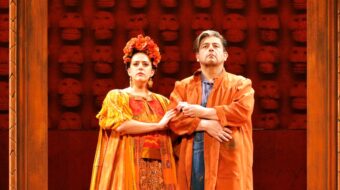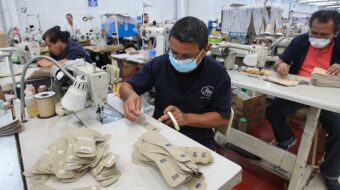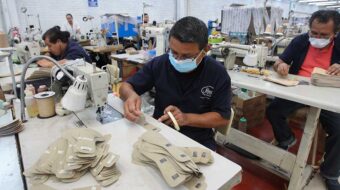
CHICAGO — I recently visited the National Museum of Mexican Art’s 21st annual “Dia de los Muertos (Day of the Dead): A New Beginning,” an exhibition here, so I could reflect on one of the most important traditions celebrated in Mexico.
Did you know that more than 500 years ago, when the Spanish landed in Mexico, they encountered native communities that practiced rituals that seemed to sarcastically mock, welcome, embrace and even honor death?
The idea of celebrating life after death and honoring those who have passed was a tradition that indigenous people had been practicing for at least 3,000 years, long before foreigners arrived on the American continent. Day of the Dead can be traced back to the Olmec, Zapotec, Mixtec, Mexica, Maya, P’urhepécha and Totonac indigenous communities.
Today’s observances
Today it is a spirited and national holiday celebrated mainly in Mexico and the Mexican immigrant community in the United States. However, to a lesser extent, variations of its customs are observed in other Latin American countries and other parts of the world, including the Philippines. Similarly themed festivities also occur in some African, European and Asian cultures.
Historically, honoring death in pre-colonial Mexico was celebrated during the entire ninth month of the Aztec calendar, starting at the beginning of August. The festivities were dedicated to the goddess Mictecacihuatl, known as the “Lady of the Dead.”
Day of the Dead, in most cases today, has merged with Catholic theology, yet it continues to maintain basic principles of the Aztec and Mayan cultures.
In most regions of Mexico, Nov. 1 is a day for honoring deceased children and infants. Adults are honored on Nov. 2.
Rich with meaning
Not to be confused with Halloween, Day of the Dead is known as portraying death joyfully, and the mood is upbeat, honoring the recently departed. It’s a view of death as the continuation of life, the belief that life does not end after death, but rather it is the beginning of a new stage, a renewal of sorts.
As the souls of the dead pass into another life, many Mexicans feel death is a special occasion. Many families in towns throughout Mexico prepare altars to welcome back their loved ones. Most visit the cemeteries where loved ones are buried and decorate their graves with “ofrendas,” or offerings. A first time ofrenda is extremely important, as it reveals the way back home for the dead. Traditions and activities in Mexico often vary from town to town.
Many Mexican families build their ofrendas (altars) or small shrines in their homes. Toys are brought for the dead children known as “los angelitos,” little angels, and bottles of tequila, mescal, pulque or atole for the adults. Trinkets are put on display with foods such as candied pumpkin, pan de muerto (bread of the dead) or sugar skulls. Many ofrendas display the Christian cross, statues or pictures of the Blessed Virgin Mary and pictures of the deceased relatives with scores of candles.
It is believed that spirits of the dead eat the spiritual essence of the ofrenda food. Celebrators who eat the food after the festivity believe it lacks nutritional value.
In some cases clothes are placed out with pillows and blankets so that that the deceased can rest after their long journey home. In some parts of Mexico people spend all night beside the graves of their relatives praying, singing and sharing anecdotes about the deceased. Others wear wooden skull masks called calacas and dance in honor of their dead relatives with colorful costumes.
Striking symbolism
Two popular symbols of the Mexican holiday are the calavera (the skull) and the calacas (skeleton masks). Both are displayed in beautiful colors and sizes. The Aztecs and other Meso-American civilizations kept skulls as trophies and displayed them during rituals, which were used to symbolize rebirth. Today, sugar skulls, made with the names of the dead on their foreheads, are used as gifts and eaten by a relative or friend.
At the museum, one ofrenda on display was dedicated to the memory of 32 Chicago Public School students who died, mostly to gun violence, during the 2006-2007 school year. Students from Big Picture High School in the Back of the Yards community put the display together. They created an empty classroom with a symbolic seat for each of the departed youth leaving behind school bags, books, soft drinks and bags of potato chips. Two chalkboards list names and ages of those who died.
“As students, the crisis of violence against youth makes us upset,” read the display. “It’s terrible having this violence around our community. These students, no matter what their situations were, should have been future doctors, lawyers or social justice leaders, and had the chance to change our community for the better.”
Gina Gailas was visiting the museum from Oregon. “It is very powerful to see the lost demonstrated this way,” she said about the ofrenda dedicated to the school children. “It makes a great impact and it gives me goose bumps,” she added.
Gailas’ uncle Wayne, a high school teacher, agreed, saying, “The kids killed is just a horrendous situation.” He comes every year to the museum and loves how the cycle of life is portrayed at the exhibit. “It’s a very healthy way of looking at death,” he said. “It makes you appreciate life more.” Day of the Dead is his favorite holiday.
Laura Dell from Wisconsin was also there. “In the U.S. we sort of ignore death and are afraid of it,” she said. “It’s nice to still feel that connection to someone who was lost,” said Dell.
Contemporary relevance
Ray Palmer, a retired medical librarian, said, “We would never celebrate this in the U.S.” He added, “The president doesn’t even allow us to see the caskets of the dead troops mounting in Iraq.”
Eileen Palmer said she likes the laughing and smoking skeletons on display. “I just think they’re splendid, they are quite whimsical,” she said.
One of Luis Tubens’ favorite ofrendas is the one that honors the fallen Mayans in Chiapas, Mexico. This particular ofrenda honors those who fought for their culture, dignity, democracy, liberty and justice for all, said Tubens, a 26-year-old tour guide for the museum.
“I think it speaks to the political situation there and allows me to explain the history of the Zapatistas and the international fight against NAFTA in Mexico.”
Other ofrendas at the museum include one about four immigrant children who came to the U.S. with their parents and died in a tragic fire last year.
Another was for Maria T. Mangual, who is remembered as a community organizer whose lifelong goal was the empowerment of Latina women and their families. Mangual helped found Mujeres Latinas en Accion (Latina Women in Action) in 1973, a local community group based in the Pilsen area.
A famous Mexican wrestler Daniel Garcia, known as El Huracan (The Hurricane) and Antonio Aguilar, a famous Mexican musician and actor, were also honored.
The exhibit is the largest of its kind in the U.S. that includes works of art from throughout Mexico and the U.S. Much of the art utilizes paper, wood, clay, woodcarvings, prints and candy. Retablos and ex-votos (both votive art forms) are also featured.
Cynthia Licea, 20, is a gallery attendant at the museum. She was born in Mexico and has been living in the U.S. most of her life. She is glad people come to learn about her history.
“It makes me proud when people come from far distances to learn,” said Licea.
The exhibit runs until Dec. 16 and admission is free. For more information, visit . Go check it out!

MOST POPULAR TODAY


Zionist organizations leading campaign to stop ceasefire resolutions in D.C. area

Afghanistan’s socialist years: The promising future killed off by U.S. imperialism

High Court essentially bans demonstrations, freedom of assembly in Deep South

Communist Karol Cariola elected president of Chile’s legislature






Comments